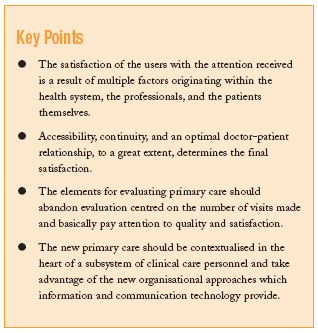The perception which the users have on the quality of the services offered by primary care centres and the health teams varies according to factors which have their origin in the different elements that have a bearing on the care process and in its results: the organisation and staff of the centres and clinics, and the characteristics of the professionals and the users themselves. Satisfaction with the care received is a result of the joint interaction of this group of factors and, for this reason, it used to be very difficult to analyse, under the perspective of cause and effect, the role of any one of them in isolation.1
Of the group of elements which define the organisation of primary health care, accessibility,1 time availability2 and continuity3-9 are the factors which most influence the perception and satisfaction of the users.
In the group of factors related to the characteristics of the professionals, those which help to establish an appropriate relationship with the patient and a pleasant and personalised care are highlighted.10,11
Some characteristics of the patients also appear to play an important role in their perception and expectations on the quality of care received; age, socioeconomic situation, the presence of chronic diseases and the poor health situation, and the frequent use of the health resources are factors which have normally been analysed in this perspective.12-19
In the work by Redondo Martín, et al in this issue of PRIMARY CARE, the perceptions and expectations of the patients are qualitatively analysed (discussion groups), translated in terms of satisfaction, on the different aspects of the care received in health centres and, from them, possible improvement initiatives are deduced. To homogenise the characteristics of the participating patients, 6 discussion groups composed of 5-7 people were established. This group compartmentalisation could be considered excessive for the objective of the study. The conclusions corroborate the role of the principle factors that influence satisfaction and which have frequently been analysed in the scientific literature, and they add some more, such as the references to the relevance of prevention activities and the deficiencies observed in the assistance for mental health in the context of primary care, which has received little attention in previous studies.20-24
As pointed out at the beginning, the satisfaction of the user/patient has its origin in many factors, but there is wide agreement in the scientific literature on considering that continuity and the accessibility to care and, in relation to these, the establishment of a patient/doctor relationship based on confidence and in the bilateral participation in decision making,25-27 and placed in a context of availability of sufficient time, are central factors in determining not only the satisfaction of the user, but also the results in terms of effectiveness and efficiency of the care rendered. In this framework, the nursing professionals are called upon to fulfil an increasingly leading role.28
This nuclear conglomerate which should characterise the increasingly important activity of primary care, as it increases the level of dependency of the patient in relation to the health and social services (chronic diseases, the physically and mentally handicapped, etc). In short, we are talking about a primary care built with the basic mission of giving personalised clinical attention and in which the resources of mental and social health have to be increasingly integrated. This subsystem of personal clinical care is different (although not separate) form technological clinical care centred in acute hospitals. This new primary care should leave its almost exclusive image of gatekeeper and patient distribution point to the technology subsystem behind completely and assume a greater capacity for resolving. As described in a recent editorial of the American edition of the British Medical Journal,29 it is necessary to redefine primary care and include in this redefinition, a new perspective of evaluating its activity which must not be centred on number of clinical visits made, but on the quality and satisfaction generated.
The full incorporation of the new information and communication technologies into the daily clinical activity will introduce profound changes in the workloads. In the previously mentioned editorial, it is pointed out that assistance via the Internet (e-mail and website) could take on an increasing percentage of care and prevention activity. It also talks of the need of new formulas of care, such as group visits of patients with chronic diseases, and of promoting the access and possibility that patients may be able to add relevant information into their clinical history, computerised and situated in the website of the centre or the professional. It is in these contexts that we have to place the new primary care and, with this, professionals capable of providing health services with an optimum level of quality and perceived as satisfactory and effective by the people, politicians and managers responsible for the health system.








